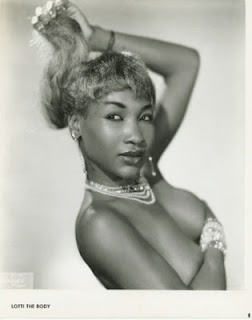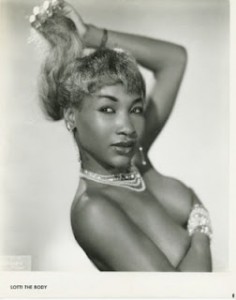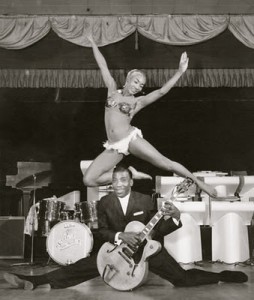
This week’s open thread will focus on Black Vaudeville and Burlesque performers.

Black Vaudeville was based on performances that came out of the movement and style of African Americans. The vaudeville years were the early 1880s until the early 1930. These acts were unique on the vaudeville scene because the performers brought in different experience that the white performers could not convey. Although African-American performers were mistreated, a Vaudeville gig was better than being a maid or farm worker. Vaudeville had what they called circuits to keep the show business at the time organized. It was difficult for a black performer to be accepted into the white circuit due to the racial issues of the time. Eventually, black circuits were created to give black performers more opportunities. Black Vaudeville made it possible for African Americans to enjoy entertainment through their own heritage.
They called her The Body. She was built like a double order of pancakes — sweet and stacked. The only light in the room bathed her as she emerged from a thick velvet curtain, incandescent, platinum hair piled high on her head. As the band struck up a slow, seductive wail, her intricately beaded gown glimmered with each step. By the end of the tune, the dress was gone, and she wore little more than heels, a few strategically placed rhinestones, and a smile.”
That’s how burlesque performer Sarah Klein (akaSparkly Devil) described Detroit’s burlesque powerhouse Lottie “The Body” Graves, in a 2005 Metro Times article about the legendary dancer. There’s been a resurgence of women of color taking up the art of burlesque, and this prompted me to wonder about Black Burlesque performers of yore, who literally shook things up and enthralled the masses… Enter Lottie “The Body” Graves; who has been hailed as Detroit’s version of Gypsy Rose Lee. While burlesque isn’t for everyone, the art, pomp and circumstance of the striptease has always fascinated me and Lottie definitely mastered it in spades, as the quintessential ecdysiast — (a term coined by writer and literary critic H.L. Mencken and coincidentally, despised by Gypsy Rose Lee, by the way).
 Born in Upstate NY, Lottie began her professional dancing career in Brooklyn at the age of 17. Classically trained, she traveled extensively before falling in love with and deciding to settle in Detroit; where she started her illustrious career as a performer at the famed Twenty Grand nightclub sometime in 1960. Known for her elaborately made costumes, deliberate dance moves, and savoir-vivre, Lottie mingled with an enviable social circle that included Aretha Franklin, Louis Armstrong, Dinah Washington, and Billie Holiday. While Lottie and her Harlem Globetrotter husband Goose Tatum spent time in Cuba, she reportedly also schmoozed with the man himself, Fidel Castro. Lottie stood out amongst other performers during her day, because of her classical dance training, which was a welcome deviation from the usual “bump-and-grind” shake-dance style employed by other exotic dancers.
Born in Upstate NY, Lottie began her professional dancing career in Brooklyn at the age of 17. Classically trained, she traveled extensively before falling in love with and deciding to settle in Detroit; where she started her illustrious career as a performer at the famed Twenty Grand nightclub sometime in 1960. Known for her elaborately made costumes, deliberate dance moves, and savoir-vivre, Lottie mingled with an enviable social circle that included Aretha Franklin, Louis Armstrong, Dinah Washington, and Billie Holiday. While Lottie and her Harlem Globetrotter husband Goose Tatum spent time in Cuba, she reportedly also schmoozed with the man himself, Fidel Castro. Lottie stood out amongst other performers during her day, because of her classical dance training, which was a welcome deviation from the usual “bump-and-grind” shake-dance style employed by other exotic dancers.
A Motor City favorite, City Council often commemorated Lottie for her contribution to the city’s breadth of entertainment. Lottie worked her magic across the U.S. and Canada, often performing in White clubs during the height of racial segregation.
A living legend, Lottie “The Body” Graves is canonized amongst a list of notable other Black burlesque and vaudeville performers in the tradition of Aida Overton Walker, Josephine Baker, and Toni Elling, who traveled the world breaking racial barriers and headlining venues with their own brand of sex appeal and talent.
Today Black striptease performers like Perle Noir, the Black Pearl are carrying on the torch from ladies like Lottie the Body.
